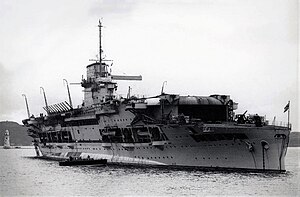
Back Глориъс (линеен крайцер, 1916) Bulgarian HMS Glorious (77) Catalan HMS Glorious (77) Czech HMS Glorious (77) German HMS Glorious (77) Spanish اچاماس گلوریوس Persian HMS Glorious Finnish HMS Glorious (77) French אה"מ גלוריוס HE HMS Glorious Hungarian
 Glorious after her conversion into an aircraft carrier
| |
| History | |
|---|---|
| Name | Glorious |
| Ordered | 14 March 1915 |
| Builder | Harland and Wolff, Belfast |
| Cost | £1,967,223 |
| Yard number | 482–484 |
| Laid down | 1 May 1915 |
| Launched | 20 April 1916 |
| Completed | 31 December 1916 |
| Commissioned | January 1917 |
| Reclassified | Converted to aircraft carrier, 1924–1930 |
| Identification | Pennant number: 77 |
| Nickname(s) | Laborious |
| Fate | Sunk by Scharnhorst and Gneisenau, 8 June 1940 |
| General characteristics (as battlecruiser) | |
| Class and type | Courageous-class battlecruiser |
| Displacement | |
| Length | 786 ft 9 in (239.8 m) (o/a) |
| Beam | 81 ft (24.7 m) |
| Draught | 25 ft 10 in (7.9 m) |
| Installed power |
|
| Propulsion | 4 shafts; 4 geared steam turbines |
| Speed | 32 knots (59 km/h; 37 mph) |
| Range | 6,000 nmi (11,000 km; 6,900 mi) at 20 knots (37 km/h; 23 mph) |
| Complement | 842 officers and men |
| Armament |
|
| Armour |
|
| General characteristics (as aircraft carrier) | |
| Class and type | Courageous-class aircraft carrier |
| Displacement |
|
| Length |
|
| Beam | 90 ft 6 in (27.6 m) (at waterline) |
| Draught | 27.75 ft (8.5 m) |
| Speed | 30 knots (56 km/h; 35 mph) |
| Range | 5,860 nmi (10,850 km; 6,740 mi) at 16 knots (30 km/h; 18 mph) |
| Complement | 793 + 490 air group (1931) |
| Armament | 16 × single 4.7 in (120 mm) DP guns |
| Armour | |
| Aircraft carried | 48 |
HMS Glorious was the second of the three Courageous-class battlecruisers built for the Royal Navy during the First World War. Designed to support the Baltic Project championed by the First Sea Lord, Lord Fisher, they were relatively lightly armed and armoured. Glorious was completed in late 1916 and spent the war patrolling the North Sea. She participated in the Second Battle of Heligoland Bight in November 1917 and was present when the German High Seas Fleet surrendered a year later.
Glorious was paid off after the war, but was rebuilt as an aircraft carrier during the late 1920s. She could carry 30 per cent more aircraft than her half-sister Furious which had a similar tonnage. After re-commissioning in 1930, she spent most of her career operating in the Mediterranean Sea. After the start of the Second World War in 1939, Glorious spent the rest of the year unsuccessfully hunting for the commerce-raiding German cruiser Admiral Graf Spee in the Indian Ocean before returning to the Mediterranean. She was recalled home in April 1940 to support operations in Norway. While evacuating British aircraft from Norway in June, the ship was sunk by the German battleships Scharnhorst and Gneisenau in the North Sea with the loss of over 1,200 lives.
© MMXXIII Rich X Search. We shall prevail. All rights reserved. Rich X Search